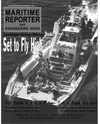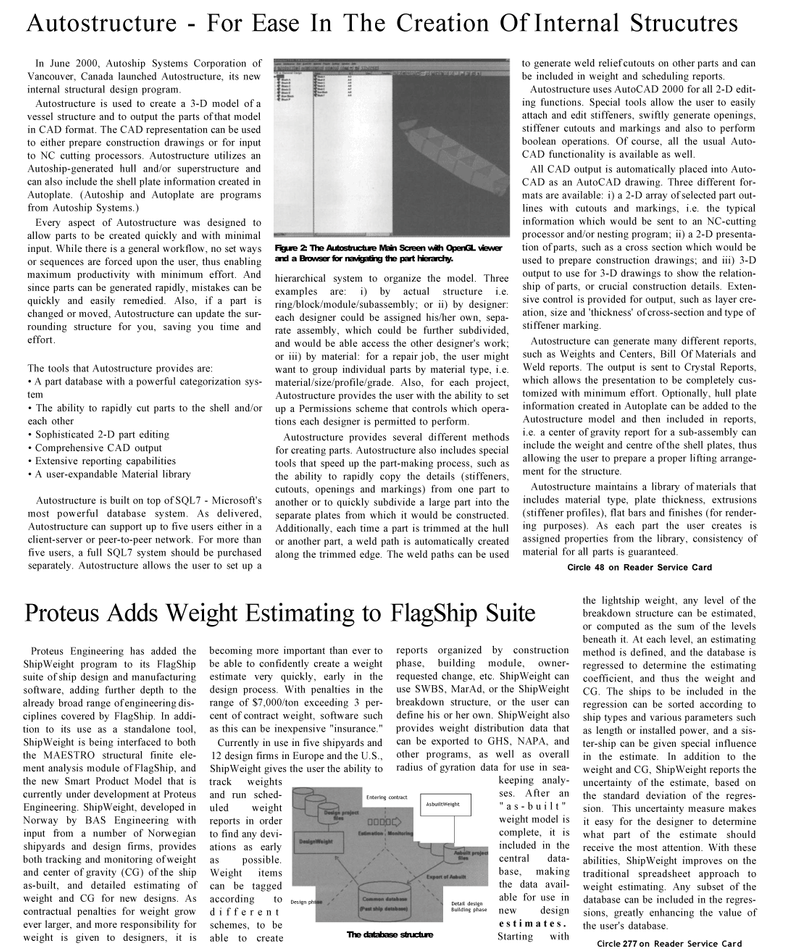
Page 38: of Maritime Reporter Magazine (January 2001)
Read this page in Pdf, Flash or Html5 edition of January 2001 Maritime Reporter Magazine
Autostructure - For Ease In The Creation Of Internal Strucutres
In June 2000, Autoship Systems Corporation of
Vancouver, Canada launched Autostructure, its new internal structural design program.
Autostructure is used to create a 3-D model of a vessel structure and to output the parts of that model in CAD format. The CAD representation can be used to either prepare construction drawings or for input to NC cutting processors. Autostructure utilizes an
Autoship-generated hull and/or superstructure and can also include the shell plate information created in
Autoplate. (Autoship and Autoplate are programs from Autoship Systems.)
Every aspect of Autostructure was designed to allow parts to be created quickly and with minimal input. While there is a general workflow, no set ways or sequences are forced upon the user, thus enabling maximum productivity with minimum effort. And since parts can be generated rapidly, mistakes can be quickly and easily remedied. Also, if a part is changed or moved, Autostructure can update the sur- rounding structure for you, saving you time and effort.
The tools that Autostructure provides are: • A part database with a powerful categorization sys- tem • The ability to rapidly cut parts to the shell and/or each other • Sophisticated 2-D part editing • Comprehensive CAD output • Extensive reporting capabilities • A user-expandable Material library
Autostructure is built on top of SQL7 - Microsoft's most powerful database system. As delivered,
Autostructure can support up to five users either in a client-server or peer-to-peer network. For more than five users, a full SQL7 system should be purchased separately. Autostructure allows the user to set up a
Figure 2: The Autostructure Main Screen with OpenGL viewer and a Browser for navigating the part hierarchy. hierarchical system to organize the model. Three examples are: i) by actual structure i.e. ring/block/module/subassembly; or ii) by designer: each designer could be assigned his/her own, sepa- rate assembly, which could be further subdivided, and would be able access the other designer's work; or iii) by material: for a repair job, the user might want to group individual parts by material type, i.e. material/size/profile/grade. Also, for each project,
Autostructure provides the user with the ability to set up a Permissions scheme that controls which opera- tions each designer is permitted to perform.
Autostructure provides several different methods for creating parts. Autostructure also includes special tools that speed up the part-making process, such as the ability to rapidly copy the details (stiffeners, cutouts, openings and markings) from one part to another or to quickly subdivide a large part into the separate plates from which it would be constructed.
Additionally, each time a part is trimmed at the hull or another part, a weld path is automatically created along the trimmed edge. The weld paths can be used to generate weld relief cutouts on other parts and can be included in weight and scheduling reports.
Autostructure uses AutoCAD 2000 for all 2-D edit- ing functions. Special tools allow the user to easily attach and edit stiffeners, swiftly generate openings, stiffener cutouts and markings and also to perform boolean operations. Of course, all the usual Auto-
CAD functionality is available as well.
All CAD output is automatically placed into Auto-
CAD as an AutoCAD drawing. Three different for- mats are available: i) a 2-D array of selected part out- lines with cutouts and markings, i.e. the typical information which would be sent to an NC-cutting processor and/or nesting program; ii) a 2-D presenta- tion of parts, such as a cross section which would be used to prepare construction drawings; and iii) 3-D output to use for 3-D drawings to show the relation- ship of parts, or crucial construction details. Exten- sive control is provided for output, such as layer cre- ation, size and 'thickness' of cross-section and type of stiffener marking.
Autostructure can generate many different reports, such as Weights and Centers, Bill Of Materials and
Weld reports. The output is sent to Crystal Reports, which allows the presentation to be completely cus- tomized with minimum effort. Optionally, hull plate information created in Autoplate can be added to the
Autostructure model and then included in reports, i.e. a center of gravity report for a sub-assembly can include the weight and centre of the shell plates, thus allowing the user to prepare a proper lifting arrange- ment for the structure.
Autostructure maintains a library of materials that includes material type, plate thickness, extrusions (stiffener profiles), flat bars and finishes (for render- ing purposes). As each part the user creates is assigned properties from the library, consistency of material for all parts is guaranteed.
Circle 48 on Reader Service Card
Proteus Adds Weight Estimating to FlagShip Suite
Proteus Engineering has added the
ShipWeight program to its FlagShip suite of ship design and manufacturing software, adding further depth to the already broad range of engineering dis- ciplines covered by FlagShip. In addi- tion to its use as a standalone tool,
ShipWeight is being interfaced to both the MAESTRO structural finite ele- ment analysis module of FlagShip, and the new Smart Product Model that is currently under development at Proteus
Engineering. ShipWeight, developed in
Norway by BAS Engineering with input from a number of Norwegian shipyards and design firms, provides both tracking and monitoring of weight and center of gravity (CG) of the ship as-built, and detailed estimating of weight and CG for new designs. As contractual penalties for weight grow ever larger, and more responsibility for weight is given to designers, it is becoming more important than ever to be able to confidently create a weight estimate very quickly, early in the design process. With penalties in the range of $7,000/ton exceeding 3 per- cent of contract weight, software such as this can be inexpensive "insurance."
Currently in use in five shipyards and 12 design firms in Europe and the U.S.,
ShipWeight gives the user the ability to track weights and run sched- uled weight reports in order to find any devi- ations as early as possible.
Weight items can be tagged according to different schemes, to be able to create
Entering contract
AsbuiltWeight
Design phi
The database structure reports organized by construction phase, building module, owner- requested change, etc. ShipWeight can use SWBS, MarAd, or the ShipWeight breakdown structure, or the user can define his or her own. ShipWeight also provides weight distribution data that can be exported to GHS, NAPA, and other programs, as well as overall radius of gyration data for use in sea- keeping analy- ses. After an "as-built" weight model is complete, it is included in the central data- base, making the data avail- able for use in new design estimates.
Starting with
Detail design
Building phase the lightship weight, any level of the breakdown structure can be estimated, or computed as the sum of the levels beneath it. At each level, an estimating method is defined, and the database is regressed to determine the estimating coefficient, and thus the weight and
CG. The ships to be included in the regression can be sorted according to ship types and various parameters such as length or installed power, and a sis- ter-ship can be given special influence in the estimate. In addition to the weight and CG, ShipWeight reports the uncertainty of the estimate, based on the standard deviation of the regres- sion. This uncertainty measure makes it easy for the designer to determine what part of the estimate should receive the most attention. With these abilities, ShipWeight improves on the traditional spreadsheet approach to weight estimating. Any subset of the database can be included in the regres- sions, greatly enhancing the value of the user's database.
Circle 277 on Reader Service Card

 37
37

 39
39
